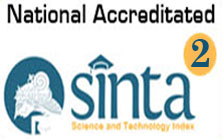The Relationship of Latrine Quality with The Incidence of Worms in The Mekarsari Health Center Area, Lebak District
DOI:
https://doi.org/10.31965/infokes.Vol22.Iss1.1635Keywords:
Latrine Quality, Family Latrine, HelminthiasisAbstract
Family latrines, crucial for sanitation, impact community health. In 2019, Banten had 70.5% latrine use, below the national 72.3%. Poor sanitation causes diseases like helminthiasis, affecting many, especially children. This study aims to determine the relationship between the quality of family latrines and the incidence of helminthiasis in the Mekarsari Health Center area of Lebak Regency. The study used a cross-sectional design. The population included all families with goose-neck latrines in the Mekarsari Health Center area, with a sample size of 88 families. Data analysis was conducted in stages using the chi-square test at an alpha level of 0.05. The results showed that nearly all respondents (93.2%) were male, 96.6% were of productive age, most had low education levels (67%), and nearly all were non-civil servants (97.7%). The majority (73.9%) had a monthly income below the Lebak Regency minimum wage (< Rp 2,944,665). There were still 17% of families with low-quality latrines, and 9.1% of family members suffered from or were infected with helminthiasis (Ancylostoma duodenale). The relationship test results showed a significant relationship between latrine quality and helminthiasis incidence, with a p-value of 0.000 (p<α). The OR value was 63,000, meaning that families with low-quality latrines were 63 times more likely to suffer from or be infected with helminthiasis compared to families with high-quality latrines. The conclusion is that there is a relationship between the quality of latrines and the incidence of helminthiasis in the Mekarsari Health Centre Area, Lebak Regency. Serious efforts are needed to empower families through health education and assistance to encourage them to improve, construct, and maintain quality latrines to prevent helminthiasis infections.
Downloads
References
Anderson, D. M., Cronk, R., Fejfar, D., Pak, E., Cawley, M., & Bartram, J. (2021). Safe healthcare facilities: a systematic review on the costs of establishing and maintaining environmental health in facilities in low-and middle-income countries. International journal of environmental research and public health, 18(2), 817.
Andrés, L., Joseph, G., & Rana, S. (2021). The economic and health impacts of inadequate sanitation. In Oxford research encyclopedia of environmental science.
Binga, W. E., Houmsou, R. S., Garba, L. C., Amuta, E. U., & Santaya, K. L. (2022). Use of rivers' water, inadequate hygiene, and sanitation as exposure of internally displaced persons (IDPs) to urogenital schistosomiasis and soil-transmitted helminthiasis in Jalingo Local Government Area (LGA), Taraba State, Nigeria. Journal of Water, Sanitation and Hygiene for Development, 12(11), 792-802.
BPS Provinsi Banten. (2019). Statistik Kesejahteraan Rakyat Banten 2019. Banten: Badan Pusat Statistik.
BPS Kabupaten Sumba Barat. (2019). Statistik Kesejahteraan Rakyat Sumba Barat 2014. Sumba Barat: Badan Pusat Statistik.
Delaire, C., Peletz, R., Haji, S., Kones, J., Samuel, E., Easthope-Frazer, A., ... & Khush, R. (2020). How much will safe sanitation for all cost? Evidence from five cities. Environmental Science & Technology, 55(1), 767-777.
Farrant, O., Marlais, T., Houghton, J., Goncalves, A., Teixeira da Silva Cassama, E., Cabral, M. G., ... & Last, A. (2020). Prevalence, risk factors and health consequences of soil-transmitted helminth infection on the Bijagos Islands, Guinea Bissau: A community-wide cross-sectional study. PLoS Neglected Tropical Diseases, 14(12), e0008938.
Ferreira, D. C., Graziele, I., Marques, R. C., & Gonçalves, J. (2021). Investment in drinking water and sanitation infrastructure and its impact on waterborne diseases dissemination: The Brazilian case. Science of the Total Environment, 779, 146279.
Holcomb, D. A., Knee, J., Sumner, T., Adriano, Z., de Bruijn, E., Nalá, R., ... & Stewart, J. R. (2020). Human fecal contamination of water, soil, and surfaces in households sharing poor-quality sanitation facilities in Maputo, Mozambique. International Journal of Hygiene and Environmental Health, 226, 113496.
Howard, G. (2021). The future of water and sanitation: global challenges and the need for greater ambition. AQUA—Water Infrastructure, Ecosystems and Society, 70(4), 438-448.
Kjetland, E. F., Gundersen, S. G., Zulu, S. G., & Taylor, M. (2020). Prevalence and intensity of neglected tropical diseases (schistosomiasis and soil-transmitted helminths) amongst rural female pupils in Ugu district, KwaZulu-Natal, South Africa. Southern African Journal of Infectious Diseases, 35(1), 1-7.
Kulkarni, S., Hof, A., Ambrósio, G., Edelenbosch, O., Köberle, A. C., van Rijn, J., & van Vuuren, D. (2022). Investment needs to achieve SDGs: An overview. PLOS Sustainability and Transformation, 1(7), e0000020.
Leta, G. T., Mekete, K., Wuletaw, Y., Gebretsadik, A., Sime, H., Mekasha, S., ... & Fenwick, A. (2020). National mapping of soil-transmitted helminth and schistosome infections in Ethiopia. Parasites & vectors, 13, 1-13.
Lo, N. C., Bezerra, F. S. M., Colley, D. G., Fleming, F. M., Homeida, M., Kabatereine, N., ... & Garba, A. (2022). Review of 2022 WHO guidelines on the control and elimination of schistosomiasis. The Lancet Infectious Diseases, 22(11), e327-e335.
Mukhlasin, Nugraha, E., & Solihudin. (2020). Sanitation Conditions and Their Impact on Public Health in Serang District. Journal of Environmental Health Research, 32(3), 156-165.
Nalbone, L., Giarratana, F., & Napoli, E. (2021). Balantidiasis: a neglected tropical disease used as a study model for a holistic approach to sustainable development in the framework of agenda 2030 goals. Sustainability, 13(22), 12799.
Okoyo, C., Campbell, S. J., Williams, K., Simiyu, E., Owaga, C., & Mwandawiro, C. (2020). Prevalence, intensity and associated risk factors of soil-transmitted helminth and schistosome infections in Kenya: Impact assessment after five rounds of mass drug administration in Kenya. PLoS neglected tropical diseases, 14(10), e0008604.
Phillips, A. E., Ower, A. K., Mekete, K., Liyew, E. F., Maddren, R., Belay, H., ... & Anderson, R. (2022). Association between water, sanitation, and hygiene access and the prevalence of soil-transmitted helminth and schistosome infections in Wolayita, Ethiopia. Parasites & Vectors, 15(1), 410.
Rasul, G. (2020). A framework for improving policy priorities in managing COVID-19 challenges in developing countries. Frontiers in Public Health, 8, 589681.
Riaz, M., Aslam, N., Zainab, R., Aziz-Ur-Rehman, Rasool, G., Ullah, M. I., ... & Akram, M. (2020). Prevalence, risk factors, challenges, and the currently available diagnostic tools for the determination of helminths infections in human. European Journal of Inflammation, 18, 2058739220959915.
Sabiq, A., Sulaiman, A. I., & Sugito, T. (2020). Designing Family Empowerment Program: Community Education in Times of Covid-19 Pandemic. International Educational Research, 3(3), 22-p22.
Shrestha, A., Six, J., Dahal, D., Marks, S., & Meierhofer, R. (2020). Association of nutrition, water, sanitation and hygiene practices with children’s nutritional status, intestinal parasitic infections and diarrhoea in rural Nepal: a cross-sectional study. BMC public health, 20, 1-21.
Surya, B., Suriani, S., Menne, F., Abubakar, H., Idris, M., Rasyidi, E. S., & Remmang, H. (2021). Community empowerment and utilization of renewable energy: Entrepreneurial perspective for community resilience based on sustainable management of slum settlements in Makassar City, Indonesia. Sustainability, 13(6), 3178.
Sukmawati, D., & Maryanti, R. (2022). Development of education and economic circulation in supporting local potential as community empowerment efforts amid the Covid-19 pandemic. Indonesian Journal of Multidiciplinary Research, 1(2), 235-250.
Tadege, B., Mekonnen, Z., Dana, D., Sharew, B., Dereje, E., Loha, E., ... & Levecke, B. (2022). Assessment of environmental contamination with soil-transmitted helminths life stages at school compounds, households and open markets in Jimma Town, Ethiopia. PLOS Neglected Tropical Diseases, 16(4), e0010307.
UNICEF. (2019). The State of the World's Children: Children, Food and Nutrition. UNICEF.
Werkman, M., Wright, J. E., Truscott, J. E., Oswald, W. E., Halliday, K. E., Papaiakovou, M., ... & Anderson, R. M. (2020). The impact of community-wide, mass drug administration on aggregation of soil-transmitted helminth infection in human host populations. Parasites & Vectors, 13, 1-12.
Wolf, J., Johnston, R. B., Ambelu, A., Arnold, B. F., Bain, R., Brauer, M., ... & Cumming, O. (2023). Burden of disease attributable to unsafe drinking water, sanitation, and hygiene in domestic settings: a global analysis for selected adverse health outcomes. The Lancet, 401(10393), 2060-2071.
WHO. (2018). Guidelines on Sanitation and Health. World Health Organization.
World Health Organization. (2019). Water, sanitation, hygiene and health: a primer for health professionals (No. WHO/CED/PHE/WSH/19.149). World Health Organization.
Downloads
Published
How to Cite
Issue
Section
License
Copyright (c) 2024 JURNAL INFO KESEHATAN

This work is licensed under a Creative Commons Attribution-NonCommercial-ShareAlike 4.0 International License.
Copyright notice
Ownership of copyright
The copyright in this website and the material on this website (including without limitation the text, computer code, artwork, photographs, images, music, audio material, video material and audio-visual material on this website) is owned by JURNAL INFO KESEHATAN and its licensors.
Copyright license
JURNAL INFO KESEHATAN grants to you a worldwide non-exclusive royalty-free revocable license to:
- view this website and the material on this website on a computer or mobile device via a web browser;
- copy and store this website and the material on this website in your web browser cache memory; and
- print pages from this website for your use.
- All articles published by JURNAL INFO KESEHATAN are licensed under the Creative Commons Attribution 4.0 International License. This permits anyone to copy, redistribute, remix, transmit and adapt the work provided the original work and source is appropriately cited.
JURNAL INFO KESEHATAN does not grant you any other rights in relation to this website or the material on this website. In other words, all other rights are reserved.
For the avoidance of doubt, you must not adapt, edit, change, transform, publish, republish, distribute, redistribute, broadcast, rebroadcast or show or play in public this website or the material on this website (in any form or media) without appropriately and conspicuously citing the original work and source or JURNAL INFO KESEHATAN prior written permission.
Permissions
You may request permission to use the copyright materials on this website by writing to jurnalinfokesehatan@gmail.com.
Enforcement of copyright
JURNAL INFO KESEHATAN takes the protection of its copyright very seriously.
If JURNAL INFO KESEHATAN discovers that you have used its copyright materials in contravention of the license above, JURNAL INFO KESEHATAN may bring legal proceedings against you seeking monetary damages and an injunction to stop you using those materials. You could also be ordered to pay legal costs.
If you become aware of any use of JURNAL INFO KESEHATAN copyright materials that contravenes or may contravene the license above, please report this by email to jurnalinfokesehatan@gmail.com
Infringing material
If you become aware of any material on the website that you believe infringes your or any other person's copyright, please report this by email to jurnalinfokesehatan@gmail.com.


















